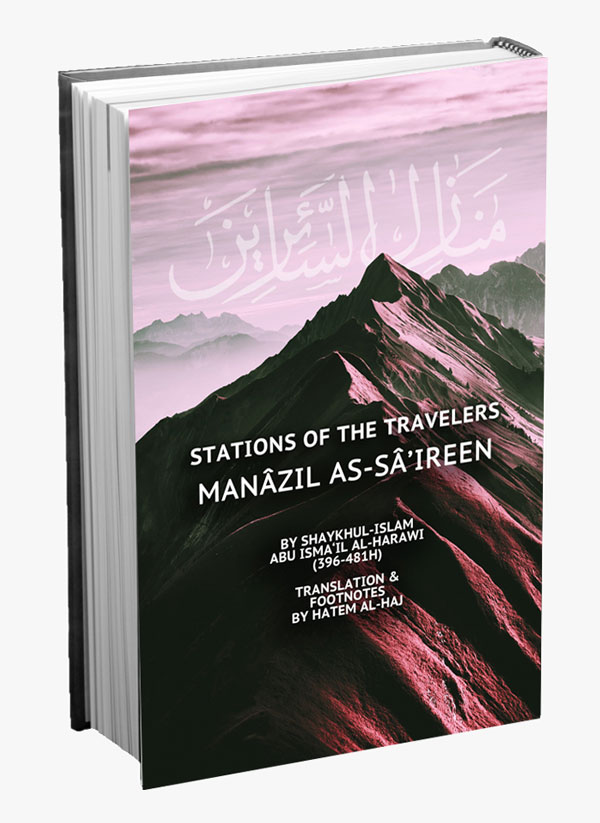Allah, the Almighty, said:
{And He revealed to His servant what He revealed.}688 [an-Najm 53:10]
قَالَ اللهُ عَزَّ وَجَلَّ:
"فَأَوْحَى إِلَى عَبْدِهِ مَا أَوْحَى"
Disclosure is the exchange of secrets between two intimate interiors.689 In this respect, it refers to transcending the veils in actuality. 690It is of three levels:
الْمُكَاشَفَةُ مُهَادَاةُ السِّرِّ بَيْنَ مُتَبَاطِنَيْنِ،وَهِيَ فِي هَذَا الْبَابِ بُلُوغُ مَا وَرَاءَ الْحِجَابِ وُجُودًا،وَهِيَ عَلَى ثَلَاثِ دَرَجَات:
The first level is a disclosure that leads to the correct realization.691 It is not constant (at this level). When it is occasional but unterminated by tafarruq (dispersion), even if their station is transiently smudged by haze, [the seeker] has reached a level at which no interrupter will divert them,692 no cause will swerve them, and no self-interest will impede them. 693This is the level of al-qâṣid (the pursuer).
الدَّرَجَةُ الْأُولَى مُكَاشَفَةٌ تَدُلُّ عَلَى التَّحْقِيقِ الصَّحِيحِ، وَهِيَ لَا تَكُونُ مُسْتَدَامَةً، فَإِذَا كَانَتْ حِينًا دُونَ حِينٍ، وَلَمْ يُعَارِضْهَا تَفَرُّقٌ، غَيْرَ أَنَّ الْغَيْنَ رُبَّمَا شَابَ مَقَامَهُ، عَلَى أَنَّهُ قَدْ بَلَغَ مَبْلَغًا لَا يَلْفِتُهُ قَاطِعٌ، وَلَا يَلْوِيهِ سَبَبٌ، وَلَا يَقْتَطِعُهُ حَظٌّ، وَهِيَ دَرَجَةُ الْقَاصِدِ.
If this becomes constant, then it is the second level.
فَإِذَا اسْتَدَامَتْ فَهِيَ الدَّرَجَةُ الثَّانِيَةُ.
As for the third level, it is the disclosure of the very reality, not the knowledge of it. It is a disclosure that leaves no mark694 indicating enjoyment, forcing a pause, or settling for images.695 The end of this disclosure is the witnessing.696
وَأَمَّا الدَّرَجَةُ الثَّالِثَةُ فَمُكَاشَفَةُ عَيْنٍ، لَا مُكَاشَفَةُ عِلْمٍ، وَهِيَ مُكَاشَفَةٌ لَا تَذَرُ سِمَةً تُشِيرُ إِلَى الْتِذَاذٍ، أَوْ تُلْجِئُ إِلَى تَوَقُّفٍ، أَوْ تَنْزِلُ على تَرَسُّمٍ، وَغَايَةُ هَذِهِ الْمُكَاشَفَةِ الْمُشَاهَدَةُ.
688The obvious relevance between the verse and the topic is that revelation is the highest form of disclosure of the realities that descend only onto the hearts of the chosen prophets and messengers. It must be said, though, that the other types of disclosure can never be compared to this highest form in their reality, certainty, scope, or significance.
689This is about subtle secrets being exchanged between two intimate companions. The exchange here is from interior to interior, thus the use of mutabâṭinayn, which means two companions with their bâṭins (interiors) connected.
690The veils of our egos and the busy phenomena around us that keep us from beholding the reality of our existence and the omnipotence, primacy, and antecedence of God, His creation of us from nothingness, our immense need for Him, and our final return to Him.
691 This is the realization of the truth as it is out there, correcting our beliefs and the realization of the prescriptive will of God, motivating us on to the right path and refining our practice. The greatest disclosure is to show the servant the details of the path, including the distinction between truth and falsehood and the realization of the shortest way to God and the flaws of the nafs that may cause his/her detriment or delay. This disclosure is better than disclosing some of the relatively unseen (such as what is in a closed box or behind a closed door) to some people. Such disclosure may happen to the awliyâ’ of ar-Raḥmân and those of Satan, though the source, significance, and purpose of it are not the same.
692 The highway bandits will not cause them to change their path.
693 His/her aspiration, determination, and collectedness will not be diminished by any of the lower self-interests.
694 There is nothing left to be qualified by marks and descriptions at this level that the sheikh dedicates to fanâ’.
695 The images refer to the exterior realities of matter and temporal phenomena, including the remnants of the self.
696 See the next chapter for the station of witnessing.
